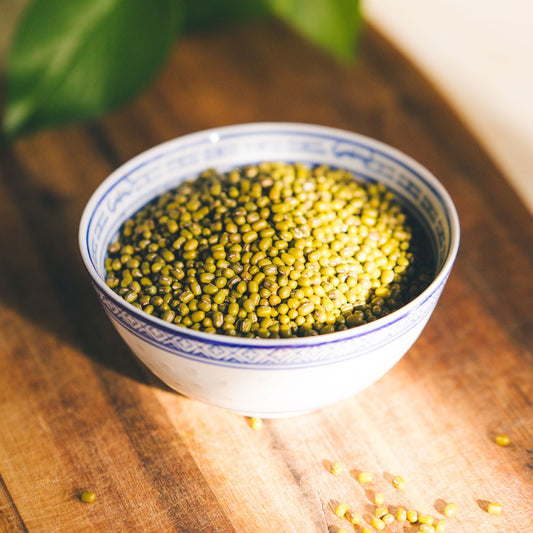Sprouts are wonderful little crunchy treats that are a popular addition to a healthy diet. Bean sprouts of all types are full of potential—they are nutritious, easy to digest, and delicious. They are satisfying to eat, easy to prepare, and fun to watch grow!
Green mung beans, also known as green moong or green gram, are small green legumes that are commonly used throughout Asia and India. In traditional Indian Ayurvedic cuisine, the use of mung beans dates all the way back to 1500 BC. In modern times, these health-giving legumes are becoming more and more popular in the West as we realize how nutritious and delicious they are. Whole green mung beans are the beans used to make “bean sprouts.”

Nutritious and Versatile
One of the reasons we love mung beans is because they are a delightfully good source of protein and fiber, and they contain natural antioxidants. When these beans are split, their green hull is removed leaving little yellow halves. In this form, they are called yellow mung dal or split mung beans. This is the dal traditionally used in kitchari.
In the cooked form, whole or split, they are used in a wide variety of culinary dishes. The dried form can be ground into flour, but their sprouted form is the easiest to digest. Sprouting activates healthy enzymes during the stages of germination, making the nutrients in the mung beans become more easily absorbed by the human body. Bean sprouts can be used in salads and sandwiches, made into noodles, or eaten alone by the handful.
With a whopping 12 grams per serving, green mung beans are a super potent source of plant based protein, which makes them a great staple for vegetarian and vegan diets.
In Ayurveda, mung sprouts are generally good for all doshas, but they are said to be best for pitta and kapha. A nice, cool sprout salad could be a wonderful pitta-pacifying addition to a summer picnic.

Sprouted Mung Beans
Directions:
Measure out ¼—⅓ cup of dried green mung beans. Rinse the beans until the water runs clear.
Add beans to sprouting vessel of choice. A sprouting jar with a mesh lid makes this process easy, as does using a fine-mesh colander. A mason jar is also a convenient option, using cheesecloth or plastic mesh secured with a rubber band for rinsing.
Cover the mung beans with 1½ cups of room temperature water and soak overnight. The beans will swell to 3 or 4 times their original size!
Drain and rinse the beans.
Cover the jar with a towel and place at an angle, upside down in a dark, cool place for 2–5 days, gently rinsing and draining twice daily. (Covering with a towel should allow for enough darkness.) A dishrack works well for this or placing the jar (or colander) in a large bowl to allow for drainage. Note: You do not want sprouts to dry out between watering, but you also do not want to overwater. Sprouts also need adequate air flow. Too many sprouts in a jar will suffocate them.
When you see the white sprouts are growing long (at least ½ inch), rinse them, dry them, and enjoy! Try your mung bean sprouts in the following recipes:

Korean Style Seasoned Bean Sprout Salad
12 minute prep time
Ingredients:
- ½ teaspoon garlic, minced
- ½ cup mung bean sprouts, fresh
- 1 teaspoon spring onion/scallions, chopped
- ½ teaspoon mineral salt
- 1 teaspoon sesame seeds
- 1 tablespoon sesame oil
- 1 teaspoon salt to add to the water
- 6 cups water
Directions:
Rinse the mung bean sprouts in cold water and discard any brown beans.
Boil the 6 cups of water in a pot and add the salt. Once the water starts to boil, turn off the heat and blanch mung bean sprouts for a moment or two.
Drain the water and run cold water on the sprouts for 1–2 minutes. Allow water to drain well.
Mix mung bean sprouts with the rest of the ingredients, serve, and enjoy!
Makes 4 Servings
Easy Mung Bean Stir Fry
Ingredients:
- 2 cups washed mung bean sprouts, fresh
- 8-ounce package buckwheat soba noodles
- 3 tablespoons coconut oil
- 1 large green onion, chopped (reserve some for garnish)
- 1 cup green beans, trimmed and cut
- ½ tablespoon fresh ginger, chopped
- 2 cloves garlic, minced
- 2 tablespoons water
- 3 tablespoons tamari
- Dash fresh ground pepper
- 6 ounces firm tofu, cubed (optional)
- 2 tablespoons sesame seeds or gomasio
Directions:
Use approximately a third of an 8-ounce package of buckwheat soba noodles. Boil noodles per package directions—usually about 7 minutes. Rinse in cool water and set aside.
In a pan, heat coconut oil over medium heat and sauté green onion, ginger, garlic, and green beans. Add water and cover with a lid, allowing the mixture to steam. Cook until beans become slightly tender. Add sprouts, tamari, tofu (if desired), and pepper. Cook until sprouts are soft and tofu is cooked through. Season to taste.
Add soba noodles and gently stir to incorporate. Top with sesame seeds or gomasio and remaining green onion. Enjoy!
Makes 2–3 Servings










